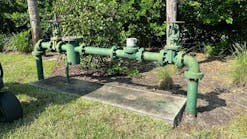Industrial stormwater programs throughout the United States have been highly effective in changing the habits of those who operate industries with the potential to create water-quality havoc through runoff from their properties.
“[Good housekeeping practice] is not rocket science,” says John Lewis, an environmental specialist and the lead stormwater inspector for the Sacramento County Environmental Management Department. “But it’s not intuitive, and you’re fighting entrenched habits. People have thought it’s OK to wash anything into the storm drain without really connecting the dots in terms of where it goes and its potential impact.”
Mark Fife agrees. He’s the stormwater coordinator for the industrial program of the Michigan Department of Environmental Quality.
“When the program started in 1992, we’d go to a site and tell them we’re doing an inspection and they’d say, “˜Why? All that stormwater is going into that drain and it’s getting treated.’ We’d say, “˜No, it’s going up to that river and carrying all of those pollutants.'”
As a result of its inspection program, the Sacramento County Environmental Management Department notes a large improvement in compliance.
“We’re not seeing the numbers of violations we initially did,” says Lewis. “Also, we’re gratified to find a much higher level of awareness as to what the rules are.”
Meanwhile, the EPA late last year issued a new Stormwater Multi-Sector General Permit (MSGP) requiring industrial facilities to implement and maintain site-specific stormwater control measures and to develop a stormwater pollution prevention plan (SWPPP).
The MSGP affects 4,100 industrial facilities in 29 sectors in five states, including Massachusetts, New Hampshire, New Mexico, Alaska, and Idaho. It replaces a previous MSGP and adds several changes, including easier-to-understand discharge requirements; improved electronic filing of Notices of Intent and monitoring reports; Web-based tools for locating water bodies and determining impairment status; and updated monitoring, inspection, and corrective action schedules.
In the meantime, the National Research Council (NRC) recently released a report calling on the EPA to overhaul its stormwater program. One of the NRC recommendations is that stormwater and other wastewater discharge permits to be based on watershed boundaries rather than political boundaries.
Another recommendation is that the EPA should drop the current system of separate permits for wastewater and stormwater regulations–within which different types of permits exist for municipalities, industries, and construction sites–and instead adopt a watershed-based permitting system encompassing all stormwater and wastewater discharges that could impact waterways in a particular drainage basin.
Sacramento County’s program–the Commercial/Industrial Stormwater Compliance Program, administered by the Water Protection Division of the Sacramento County Environmental Management Department–has been so successful that it received the EPA Clean Water Act Recognition Award for Stormwater Management Excellence.
Lewis believes the program’s efficiency and function are the elements that attracted top honors. But the process took a great deal of crafting.
“The permit requirements are pretty severe,” he says. “When our MS4 [municipal separate storm sewer system] permit was reissued in 2002, it required, among other things, that this particular program be in place by June 2004.”There were seven permitees included in the permit, with an inventory of 5,000 businesses spread among nine categories.
“The county and the cities within the program were all scratching their heads wondering how we were going to do this,” says Lewis. “It was a daunting task.”
Other California communities had implemented similar programs, but looking across the state, “There wasn’t a lot of consistency in terms of how programs were being implemented,” says Lewis. “People just worked with the resources they had and forged the alliances they were able to forge.”
In implementing the program, Sacramento county managers considered how to manage the county’s inventory of 5,000 businesses.
“The permitees agreed to contract the program out to the county Environmental Management Department, because we have our CUPA [Certified Unified Program Agency] inspectors in the field, and our health inspectors, and the CUPA and health inspections overlap a large number of those facilities,” says Lewis. “Because CUPA–which addresses hazardous materials–and health were both under one department, it was even easier to get that buy-in.”
All of the cities signed a memorandum of understanding with the Sacramento County Environmental Management Department, enabling the agency to dovetail the stormwater inspection requirements along with other existing inspections.
The restaurant industry represented the largest group in the inventory, so buy-in from the health department was crucial.
Sacramento County’s stormwater management program, which began in 2004, entails stormwater compliance inspections every three years at businesses that are common sources for pollutants. These industries include auto repair and body shops, auto dealerships, auto rental agencies, gas stations, restaurants, nurseries, kennels, equipment rental businesses, and facilities covered under the state’s General Industrial Stormwater Permit, which also have the potential to contributing to water degradation.
Lewis says other agencies with which he’s communicated have had less success than Sacramento.
“I think part of that is because their CUPA people and their health people aren’t necessarily under one roof, so the question is, why would they want to take on this extra work? All of the people involved with implementing our program were under one roof and we got great buy-in from all of our inspection staff. We’ve got great people out there doing the inspections on our behalf with a good attitude, and that just made all the difference.”
Lewis credits environmental specialists Lea Gibson and Sean Daneluk with the program’s success.
Consistency also is crucial. All of the jurisdictions reference the county’s stormwater ordinance, giving inspections some teeth.
“As we’re out in the various cities with Sacramento County where we’re implementing the program at those facilities we regulate on behalf of the stormwater permitees, we’re enforcing per the county’s stormwater ordinance,” says Lewis. “We don’t want to be struggling with issues of how to enforce differently in different jurisdictions, because all of these seven jurisdictions have their own ordinances,” he adds. “Some of them are more different than others, so when it comes to us doing an enforcement action at a facility we regulate, whether it be in the city of Galt, the city of Sacramento, or the unincorporated county, it all refers to the county’s stormwater ordinance.”
Thus, consistencies are realized through following the same enforcement procedures, appeal procedures, and using the same notices.
“All of the stormwater permitees got together and pooled resources to put together very industry-specific outreach material,” says Lewis. “We give out the same outreach material depending on business type wherever we are within the county. If you do things differently in the seven different jurisdictions, it’s not only confusing to the inspection staff, but also very confusing to the regulated community.”
A lot of the common violations occur at restaurants, including unattended grease spills, liquids leaking out of Dumpsters, inappropriate surface-washing discharges, and employees sending the detergents or degreasing agents used to clean up grease and food spills on pavement down into the storm drain.
Other common pollutants that end up in the stormwater–either intentionally or accidentally–include discharges from commercial vehicle washing and detailing, equipment cleaning, stone cutting, wet sanding, pressure washing, steam cleaning, and outdoor storage of uncovered items such as oily vehicle parts.
Additional violations occur through sediment trackout from dirty or unpaved facilities onto public streets, poor waste and materials management in outdoor exposure of pollutants to stormwater contact, and poor spill response and leak and spill management.
Lewis says that although a business operator may be cognizant of stormwater rules, the violations may occur during an inspection or while an inspector is driving by and sees an employee doing something wrong.
“It turns out the employee was hired a month ago or maybe there are language barriers,” he says. “You can’t assume the operator of the facilities should have known better. Sometimes you just have to give the benefit of the doubt, keeping in mind stormwater compliance awareness is not intuitive, because people have been using the storm drain system as their waste disposal route for so long without consequences because it used to be legal, so you’re fighting habit.”
One of those habits is another common violation: people washing vehicles near a storm drain. While residential vehicle washing near a storm drain is allowed, washing vehicles at a commercial or industrial site with the runoff going into the storm drain is not.
That’s a tough one to get people on board with, says Lewis. Sometimes they’ll ask how the practice is different from when it rains on a vehicle.
“The response is that, as you are a business operator, it’s expected that you will maintain your operations and your facility in a manner that prevents stormwater contamination to the extent practicable, so that means washing your vehicles periodically, but doing so in a compliant manner so you don’t have a huge accumulation of grime and muck,” says Lewis. “That’s getting washed into the storm drain when it rains.”
It’s easier to justify requiring a larger business to develop infrastructure to wash equipment and vehicles in a complaint manner, but there can be some push-back to the suggestion that a business with a few vehicles build a wash pad to keep that small number of vehicles washed, Lewis says.“We explore other options, like taking the vehicle to a nearby car wash that’s piped to the sanitary sewer,” he says. “Sometimes that works if there’s one nearby, but maybe there’s not one nearby. We really understand that this can be an impact to the business community, especially in hard times like now, because the economy is so bad, and we really feel the pain of these businesses. So we really try to be flexible.”
That flexibility includes the option of establishing a gravel area behind the business where the runoff from vehicle washing can soak into the ground, with the provisions that hazardous materials, degreasing agents, and materials with high pH not be used in the process.
“And you can’t let this area overflow into the storm drain, because that would defeat the purpose,” says Lewis. “You can’t create nasty, muddy conditions and kill vegetation, but if you can use this gravel area in a manageable way, then we are willing to let that be your compliance strategy.”
The county’s extensive education efforts underscore its success, says Lewis.
“We do put a lot of information out there,” he says. “We mailed out industry-specific literature in the beginning of the program before we started the inspections and then periodically throughout. We provide the literature when we do the inspections, as well as what we provide verbally. We pick various industries and do a workshop for each industry, such as gas stations, auto repair, or restaurants.”
Some of the workshops are so popular that a second one must be planned for the following day to handle the overflow, Lewis adds.
Sacramento County also partners with the Business Environmental Resource Center and Sacramento’s utility district in conducting outreach workshops.
“It’s a matter of getting that awareness out there,” says Lewis. “You have to be repetitive and get the information out there from a number of perspectives: literature and workshops. We are also available by phone for our business operators when they have questions. Through our partnership with the Business Environmental Resource Center–a county agency my department helps fund–we provide free, confidential compliance information to businesses.”
Businesses with violations need to develop structural or nonstructural best management practices (BMPs) or pollutant control measures; Sacramento County does not specify what those are, “because we figure the business operator knows better than we do,” says Lewis. “We give them some guidance, and if that guidance isn’t enough, then we refer them to the Business Environmental Resource Center, which gives them one-on-one attention.”
Sacramento County also has done the legwork for industrial and commercial institutions by providing information on BMPs and how to use and install them. The county also offers the industrial and commercial sector detailed information on the creation of a SWPPP.
On the issue of the NRC suggestion of combining the three different types of stormwater permits–municipal, industrial, and construction site–into one and putting them all under municipal jurisdiction with a lead municipality, which would get more funding, Lewis comments, “Funding would be awesome.”
The industrial stormwater permit program is an unfunded mandate, but in Sacramento, program costs are recovered from regulated businesses.
“It is an impact to our businesses, especially now when the economy is so tight,” says Lewis. “Our fees are pretty low, but they are still an impact. We regulate anything from an enormous facility down to the little mom-and-pop auto body shop or small restaurant, so we know it’s an impact to them.”
What makes it more difficult for businesses is that one of the county’s nine categories–general industrial stormwater permit facilities–falls under a statewide stormwater permit due to the SIC code and the business’ industrial output.
“Once they are under the permit, the state requires us to inspect and regulate them,” says Lewis. “The state is charging them more than $1,000 a year to be under this permit, and then we have to recover our costs for inspection. The business operators feel they are being double-billed, and some of them are understandably not terribly happy about that. We would love to see money come in from the federal government or elsewhere so there wasn’t such an impact to these businesses.”
Lewis believes that while basing stormwater programs on watersheds rather than political boundaries, as is recommended by the NRC, is “nice in principle,” he also says, “The fact of the matter is that jurisdictional boundaries are there, so when you step into a new jurisdiction, you have to establish legal authority to inspect, enforce, and bill businesses. That just doesn’t happen automatically because a given community happens to feed into or be part of your watershed. While it very much makes sense, it’s just the unfortunate reality that it is easier said than done.”Other industrial stormwater programs in the United States are also finding success. Case in point: Michigan’s stormwater program.
Industrial site operators can be certified through training at the state’s district offices.
“The first permit was issued back in 1992,” says Fife. “We do not have a multisector permit like the EPA; it’s a general permit. We do not require any sampling for the most part, which is quite a bit different from the EPA.
“What we do require is that an operation have a certified stormwater operator in charge of the SWPPP,” he adds. “That’s someone who’s certified by us. We give training, and they can take an exam to become certified.”
Although industrial operations can hire a consultant, Fife says, “We recommend that organizations have people certified in-house–and usually multiple people, for that matter.” Michigan’s industrial stormwater program regulates entities ranging from small tool and die shops to the Big Three automakers, for a total of more than 3,000 facilities. Additionally, the state is in the process of developing a site-specific general permit for salvage yards, which have presented many problems in the past.
The state also has a general stormwater permit with short-term characterization for operations that want to discharge secondary containment structures, perhaps a site of contamination with stormwater concerns, or an operation identified by the state as a significant contributor that needs monitoring.
“Depending on the situation, people are required to develop a sampling plan and do two to four sampling events to see what the characterization of that waste is,” says Fife.
Although all of Michigan’s industrial regulated entities are covered under a general permit, they are broken down into five different general permits based on different watersheds, which Fife says breaks up the state’s workload for reissuing permits.
“At a bare minimum, we’ll inspect a facility once every five years,” he says.
Common violations focus on not having a SWPPP or not implementing the one that exists, he says. Penalties can be as high as $25,000 per day per violation, and there can be multiple violations.
“We’ve made a lot of headway over the past 10 to 12 years, but we still have a long way to go,” says Fife. “A lot of it is a greater awareness of stormwater and its potential impacts.”
There’s an added benefit to industrial operations that comply with stormwater requirements, he notes. “There’s an incentive to get rid of all that junk that you may store outside, because the whole goal of this program is that if you can minimize or eliminate your exposure of materials outside, then that’s a good thing. A lot of people will change practices and eliminate what they had outside, and then they’re eligible to get out of the permit, which is good. They can recycle and reuse. They can save money.
“If people are able to store stuff inside or get rid of stuff and get the government off their back, they’ll do it. That’s the big success–getting people to do what they’re supposed to.”
John Kosco, P.E., is with Tetra Tech, a company that provides environmental engineering and consulting services. Kosco helped to set up Phase II of the National Pollutant Discharge Elimination System program for the EPA. In August 2009, he gave a presentation at StormCon in Anaheim, CA, on the new MSGP for industrial stormwater discharges. His company has prepared a monitoring and sampling guide for the EPA to help industrial facilities comply with the permit’s monitoring requirements.
The MSGP was significantly rewritten, says Kosco, and was three years in the making.
“The main point of what they did is split out what they call the effluent limits from the SWPPP requirements,” he explains. “One of the general permits had SWPPP requirements. If you’ve never developed a SWPPP, you didn’t really know what you were supposed to do.
“So the EPA basically said, “˜Here’s a set of 12 different things you need to do whether you have a SWPPP or not. Stormwater measures need to be described in the SWPPP, but if you don’t have a SWPPP, you still need to do them.’ Those became the effluent limits.”
Another new factor is the requirement of annual reporting.
“It’s an update of the old one, so it’s going to hit the same type of facilities as before,” says Kosco. “It only applies in five states and various territories where EPA still issues permits. But hopefully it’s a little clearer to the permitees, and they can understand the requirements a little easier. There is less ambiguity in terms of what they’re supposed to be doing to comply.”
Meanwhile, in the rest of the country, many larger Phase I municipalities have industrial stormwater programs, while many Phase II communities do not, Kosco says.
“But even some of the larger ones push it off to the states, because the states issue general permits,” he adds. “Some cities, like Sacramento, have taken a more proactive approach. And there are some other cities in California that are focusing more on commercial businesses, in addition to heavy industry, to try to control stormwater problems from those, too.”
As for the NRC recommendation that all stormwater programs be based on watershed boundaries rather than political boundaries, Kosco says that’s something the EPA has discussed for a long time, but in reality, it’s no easy task.
“All of these things are good in concept until you start to try to apply them,” he says. “The EPA has talked about watershed-based permits. There’s even EPA guidance on watershed-based permitting, but it’s taking someone to actually write the first permit to do it that way, and not many have.”But politics can play a role in advocating for strong programs across the board. Such is the case in California, where Kosco’s company has done a lot of audit and inspection work.
“A lot of cities there have a good industrial program, mainly because the state has pushed them to do that,” he points out.
He agrees that regulatory challenges can be daunting. There are some areas of the country, however, where the inspection process has more teeth.
“Washington State has ticketing authority for its inspectors,” he says. “Usually you have to go through a Notice of Violation in a more formal process, but now they’re allowed to issue $500 to $3,000 tickets when they find a violation at a site. It’s pretty new. It will be interesting to see how that turns out.”
Inspections and enforcement will play a key role going forward, Kosco says.
“A field presence is needed out there,” he says. “We’ve done over 2,000 industrial inspections for California. We did a pilot project of 100 inspections in the Los Angeles area and did re-inspections six months to a year later. We found that the compliance rate on those facilities shot through the roof just because they were inspected and they were reminded of their permit requirements. If there is no field presence, a lot of these guys don’t pay any attention to the requirements. Definitely having a strong presence in the field is necessary.”
Some of the common violations Kosco’s company finds involve failure to update or implement all aspects of a SWPPP.
“They have a plan with all of these BMPs, but they never implement or follow them,” he says. “They may have paid a consultant to develop their SWPPP, and they just put it on a shelf and waited for someone to come tell them what to do. If they’re going to pay someone to put together this plan, they need to implement their plan.”
Poor housekeeping is another common violation.
“If they have good housekeeping practices–even if they’re not fully implementing their SWPPP–they’re usually 99% in compliance,” he notes. “If it’s a messy site, they’re more likely to have all kinds of other problems there, too.”
What will industrial stormwater programs look like going forward?
The NRC says that reversing the degradation of freshwater resources and ensuring progress toward the Clean Water Act’s goal of “fishable and swimmable waters” can take place only through radical changes in the EPA’s stormwater program. In addition to its recommendations of basing stormwater and wastewater discharge permits on watershed boundaries, the NRC calls for an integrated stormwater and land management approach that focuses more on increased water flow and less on chemical pollutants.
The NRC report points out that heavy snow or rain events in urban areas create concentrated bursts of high water discharges that flow over impervious surfaces and pick up pollutants such as garbage and chemicals, which are ultimately conveyed to nearby water bodies. Additionally, the high water volume–generally not regulated by the EPA–acts to increase streambank erosion and pollute surface water with sediment, the report contends.
The NRC charges that there has been little accountability with regard to stormwater regulations and questionable impact on water quality. A watershed-based permitting system encompassing all stormwater and wastewater discharges could impact waterways in a particular drainage basin,
according to the NRC.
The NRC also suggests that construction and industrial sites be integrated under the jurisdiction of associated municipalities in the absence of adopting watershed-based permitting.
The NRC report concedes that the regulatory challenges are daunting, with more than 100,000 discrete point-source facilities discharging stormwater, and that federal and state permitting authorities do not have sufficient numbers of personnel to inspect and enforce stormwater regulations.
The NRC points out that land use management is a key factor going forward in stormwater regulatory programs as further land development creates an increase in impervious cover. It suggests that permit programs be predicated on rigorous projections of future growth and changes in impervious cover, or that incentives be offered to decrease the impact of land development.
Greater accountability is needed in monitoring cumulative contributions of multiple sources and pollutants in the same watershed, because most discharges are regulated on an individual basis, the report says.
The NRC also suggests further stormwater control measures, including conserving natural areas, reducing hard surface cover such as roads and parking lots that channel stormwater into waterways, and retrofitting urban areas with features that hold and treat stormwater.
The federal government should provide more financial support to state and local efforts to regulate stormwater, the NRC recommends. Although there are five times more stormwater permit holders than wastewater permit holders, funds for the latter are greater than for the stormwater program, according to the NRC.






